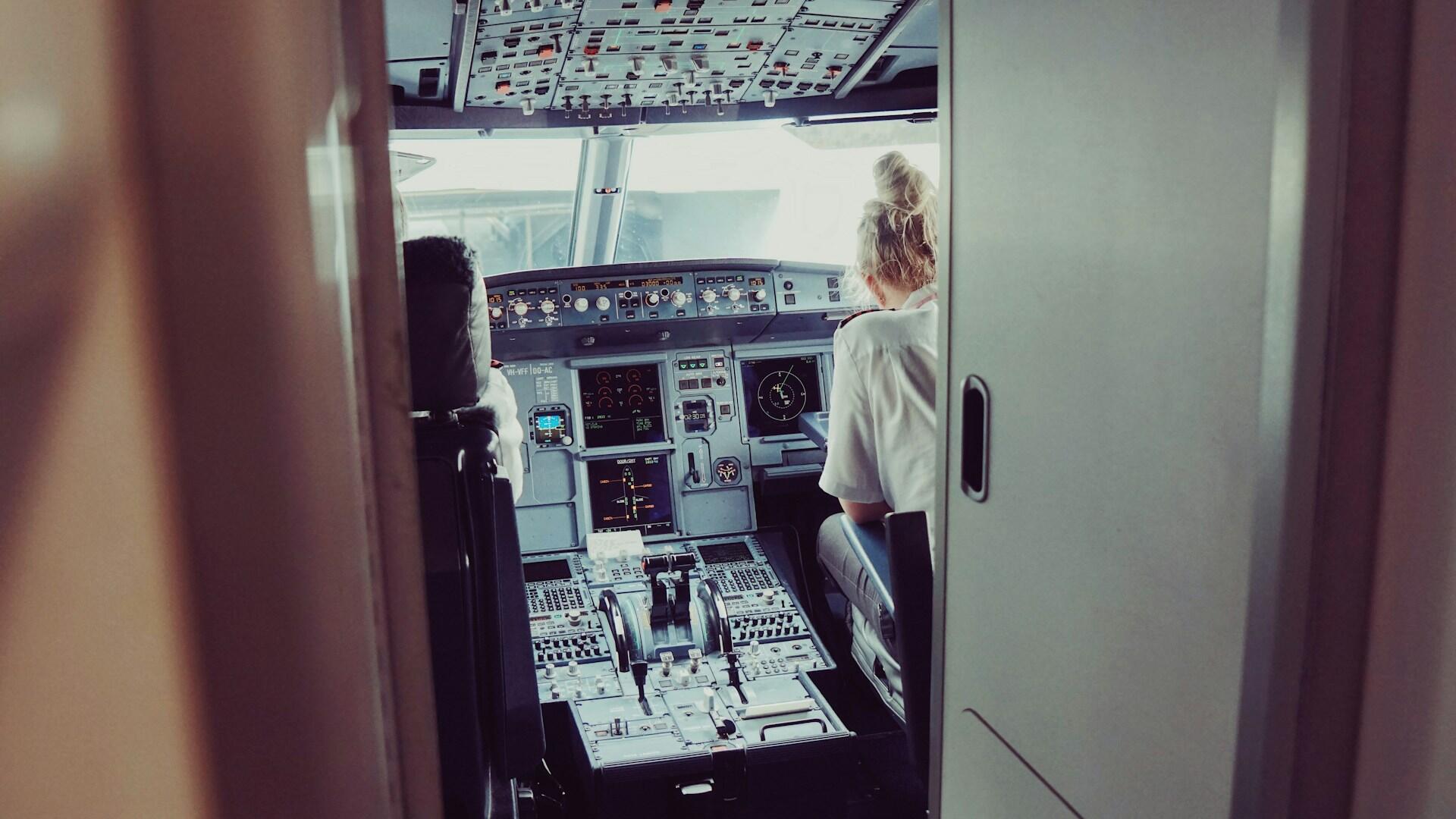It’s not as unusual as you might think.
“Has anyone ever seen their airline pilot leave the cockpit mid-flight to chat with the flight attendants? One hour into a three-hour flight, and the captain left the cockpit to just…hang out.”
This call for crowd-sourced answers came via an X (formerly Twitter) post from Fodor’s Senior Digital Editor Nikki Vargas.
“The co-pilot has now left the cockpit to… hang out with the flight attendants,” she continued. “The co-pilot opened the cockpit looking for the captain with a look of, ‘What are you doing?’ This is wild.”
Cue this customer sleuth, running Mrs. Doubtfire-style through Vargas’s comment section, bellowing, “Help is on the way, dear!” I also felt the need to initiate an investigation after seeing questionable flight crew behavior and tapped into the one trustworthy source who would give me the real scoop: my husband.
My husband, a pilot for a major airline, was sitting right next to me on a recent flight from Cabo San Lucas to Seattle. We were detained as a captive audience courtesy of the activated seatbelt sign above us when I started my sharp-elbow-to-the-ribs inquisition by gesturing towards my own suspicious scene unfolding near the closed cockpit door and the flight crew.
Recommended Fodor’s Video
The first-class assigned flight attendant maneuvered a snack and beverage cart, perfectly blocking the aisle and access to the lavatory located next to the cockpit door. With a lack of bathroom availability immediately triggering a plane full of bladders into crisis mode, I fired off an annoyed question as to why, of all places, the cart had been haphazardly discarded there.
My husband, slipping into his professional pilot persona, recognized the conversation for the interrogation it was. He patiently inspired further thought processing by asking me if that cart could have been purposefully placed, as opposed to haphazardly discarded, in that location for a specific purpose. I turned my intense attention to the scene and, as if additional proof had been ordered, I watched as the flight attendant plucked the phone from its mount on the wall in the forward galley to answer an incoming call.
“Why is the flight attendant locked in the cockpit with the pilot? Is something going on?”
The call lasted only a few moments before she hung up and moved to stand right in front of the cockpit door. She waited expectantly until it popped open and then moved into a seemingly practiced, rotating dance step as the pilot stepped out of the cockpit and straight into the lavatory, and the flight attendant stepped into the cockpit to join the second pilot. The door promptly snapped closed behind her. A second flight attendant checked the closed door, seemingly satisfied it was locked.
I suspiciously turned to my husband and asked, “Why is the flight attendant locked in the cockpit with the pilot? Is something going on?”
“Because of regulations issued by the Federal Aviation Administration (FAA). It’s a requirement for a second person to be present in the cockpit with the remaining pilot. Sometimes, it will be a flight attendant; at other points, it might be a third pilot located in the jump seat,” he explained.
It’s a safety protocol that a second person is present to sound the alarm to the pilot in the lavatory or galley should the one flying the plane encounter any scenario that prevents them from suddenly doing so. This is why there is a requirement worldwide that two pilots be assigned to every major airline flight, with one pilot always present at the control panel, flying the plane. Safety in numbers and redundancy for the win, always.
“Always?” I challenged my husband.
I continued my ruthless interrogation by demanding: “Can the plane be left unattended but set on auto-pilot or cruise control?” My husband, now sensing the inquisition at hand, answered as the professional pilot he is by detailing that, “The plane can never be momentarily unmanned even in autopilot/cruise control mode.
“Can the plane be left unattended but set on auto-pilot or cruise control?”
“There absolutely had to be a pilot who was left in the cockpit to fly the plane, even if you saw two pilots leaving the cockpit,” he insisted. “An explanation for this could be that two pilots were assigned to fly a route, and a jump-seat pilot was also present in the cockpit. When two pilots were seen leaving the cockpit, it had to have been one assigned pilot and the jump-seat pilot, while a third was left to fly the plane.”
I pressed even harder. “You say the cockpit can never be left unattended by FAA standards but is it possible?” His sigh left me with the impression of a “yes, but” for an answer as he went on to explain.
“Leaving a cockpit unattended is a federal crime,” he said. “Think: attempted murder of an entire flight of people. Every crew of flight attendants and pilots knows this and will be, at the very least, fired as soon as they land and arrested as soon as possible if they do not intervene and report the incident immediately. It’s a known foundational, industry-wide commandment that you do not leave the cockpit completely unattended.”
“And if a customer is still concerned by what they observed, what should they do? Can they speak with a flight attendant about it? Can they report it to the airline?” I asked. With zero pause to consider, my husband answered a resounding yes.
“If a customer’s perceived experience is that something unsafe happened, it needs to be reported, and airlines will thank you for helping them make the industry safer by reporting that behavior,” he added.
Satisfied for now, I turned to continue my stakeout of the scene from my seat on my own flight, watching as the pilot stepped out of the bathroom and into the forward galley where he stood, drinking a soda. Several minutes passed by as the pilot chatted with a flight attendant, mirroring the scene Vargas had observed on her own flight.
Watching it play out, it’s understandable that questions would be raised when the perception is that the pilot, who we think should be flying the plane, is seemingly hanging out to socialize in the galley. As perceptions go, the face-value evidence looks damning, but the explanation as to what was more than likely occurring was the descent briefing.
Sometimes done on the phone from the cockpit or in person to be combined with a bathroom break and a quick stop in the galley for a soda, the captain, specifically, will issue instructions to the lead flight attendant as to what the physical descent of the plane’s landing will look like. Turbulence expectations, the pace of the descent, and how long the flight attendants will have to complete their list of tasks before being absolutely required to sit down and buckle up all have to be carefully orchestrated since timing is crucial to keep a cabin full of passengers and flight crew safe.
I watched as the pilot ended his conversation to grab the wall-mounted phone, spoke a few words, and hung up. He stepped to the cockpit door as it popped open, and the waiting flight attendant stepped out to the forward galley. The pilot moved into the cockpit, closing and locking the door behind him. The door was double-checked by the flight attendant to confirm it was locked before she moved toward the snack and beverage cart. Sitting its cumbersome weight and locked wheels right where it was left between us passengers and the most vital part of the aircraft, I could now see it for what it was: an innocuous line of defense, protecting the cockpit door in the very brief moments when it was unlocked.
I looked next to me, then back at the snack cart, and my pilot husband nodded, knowing I had wrapped up the interrogation as I tilted my seat back and released my death grip on the armrest to declare my investigation case closed.




